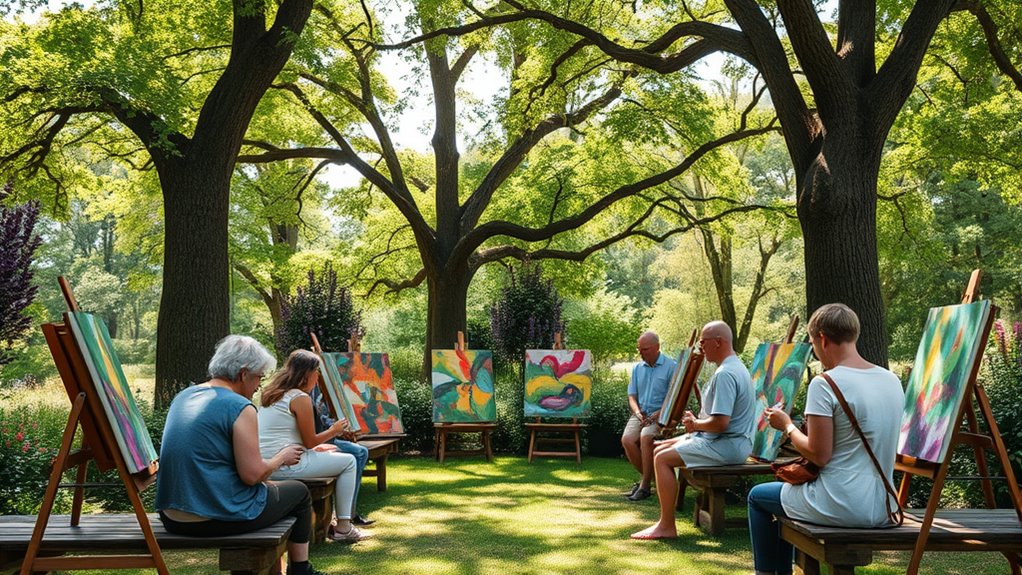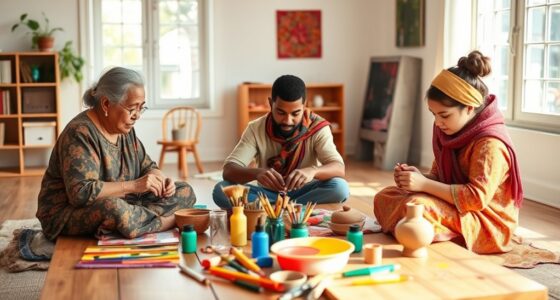Integrating nature into your art therapy sessions can boost healing, foster genuine self-expression, and create a calming environment. By incorporating natural materials and outdoor activities, you’ll help clients reconnect with their senses, reduce stress, and gain emotional insights. Nature’s textures, sounds, and scenery inspire organic creativity, making sessions more meaningful. If you keep exploring, you’ll discover effective ways to deepen these therapeutic benefits and enhance your clients’ growth through outdoor artistic experiences.
Key Takeaways
- Incorporate outdoor environments to foster mindfulness, emotional expression, and a calming atmosphere during art therapy sessions.
- Use natural materials like leaves, stones, and twigs to enhance tactile engagement and sensory awareness.
- Encourage clients to draw inspiration from natural textures, colors, and sounds for organic, spontaneous artwork.
- Facilitate outdoor activities that promote physical interaction with nature to deepen emotional insights and primal connection.
- Recognize the therapeutic benefits of outdoor creativity, including stress reduction and increased self-awareness, to strengthen outcomes.

Have you ever considered how nature can enhance the healing power of art therapy? When you incorporate the natural environment into your sessions, you create a unique space that fosters a deep sense of connection—both to yourself and to the world around you. A strong nature connection can markedly boost the effectiveness of art therapy by grounding your clients and helping them feel more present. By integrating outdoor creativity, you open new avenues for expression that aren’t confined by indoor walls or traditional art supplies. Instead, you allow your clients to draw inspiration directly from the environment, whether it’s the textures of bark, the colors of the sky, or the sounds of rustling leaves. This approach encourages a more organic, spontaneous form of creativity that often reveals emotions and thoughts that might be difficult to articulate verbally.
Outdoor creativity isn’t just about using the environment as a backdrop; it’s about actively engaging with it. As you guide your clients to create art amidst nature, they’re likely to experience a sense of liberation from conventional constraints. They might collect natural materials like stones, leaves, or twigs to incorporate into their artwork, fostering a tactile connection that heightens their sensory awareness. This process helps clients reconnect with their innate instincts, encouraging them to explore their feelings through physical interaction with natural elements. When you facilitate this kind of outdoor creativity, you’re not only providing a safe, supportive space but also enabling your clients to tap into a primal source of inspiration, which can be incredibly healing.
Engage with nature through tactile materials to unlock primal inspiration and deepen emotional healing in art therapy.
Additionally, working outdoors can reduce feelings of stress and anxiety, making it easier for clients to open up and express themselves honestly. The natural environment acts as a calming influence, helping to lower cortisol levels and promote relaxation. This serenity enhances their ability to focus, reflect, and create without the usual distractions or self-judgment that can occur indoors. As a result, their artwork often becomes a more authentic reflection of their inner experiences. You’ll find that clients may produce more spontaneous and heartfelt pieces when surrounded by the sights and sounds of nature, which can be powerful indicators of progress and emotional release.
Incorporating nature into art therapy sessions isn’t just a trend; it’s a meaningful way to deepen the healing process. By fostering a genuine nature connection and encouraging outdoor creativity, you help clients access a restorative space within themselves—one that’s rooted in the earth and open to endless possibilities for growth and self-discovery. Additionally, understanding the benefits of outdoor creativity can help you optimize session outcomes and strengthen the therapeutic process.
Frequently Asked Questions
What Are the Best Outdoor Environments for Nature-Based Art Therapy?
You should choose outdoor environments like parks, forests, or gardens for nature-based art therapy. These spaces offer rich natural art materials like leaves, stones, and flowers, enhancing creative expression. Engaging with these environments provides ecotherapy benefits, reducing stress and fostering mindfulness. Make certain the setting feels safe and accessible, allowing clients to connect deeply with nature while exploring their emotions through art.
How Can Virtual Nature Experiences Be Incorporated Into Therapy Sessions?
You can incorporate virtual nature experiences into therapy sessions by leveraging digital immersion and virtual reality technology. Walk clients through immersive virtual environments that mimic natural settings, encouraging them to create art inspired by these experiences. This approach helps clients connect with nature even when outdoor access isn’t possible, fostering relaxation and self-expression. Use VR headsets or digital simulations to enhance engagement and deepen the therapeutic process through immersive, nature-based interactions.
Are There Specific Art Materials That Work Better With Natural Elements?
Like an artist’s palette from a Victorian painter, natural pigments work beautifully with natural elements, bringing earthy tones to your projects. Recycled materials such as leaves, bark, and stones also enhance your art therapy, fostering sustainability and connection. These materials encourage tactile engagement and deeper reflection. Using natural pigments and recycled items creates a harmonious blend that deepens your clients’ connection to nature, inspiring mindfulness and emotional healing.
How Do I Ensure Safety When Working Outdoors With Clients?
To guarantee safety outdoors, you should implement risk management strategies like conducting site assessments beforehand and checking weather conditions. Always have an emergency preparedness plan in place, including first aid supplies and clear communication methods. Keep clients within designated safe areas, monitor their well-being, and be aware of potential hazards like uneven terrain or insects. By proactively managing risks, you create a secure environment for your clients to explore nature creatively.
What Are the Cultural Considerations When Integrating Nature Into Therapy?
Imagine working with a client from a culture where certain plants symbolize spiritual beliefs. You need to respect their tradition sensitivities and avoid misusing cultural symbolism. Always research cultural backgrounds and ask clients about their comfort levels with specific natural elements. This approach guarantees your therapy respects diverse traditions, fostering trust. Being culturally sensitive helps you create a safe, inclusive environment where clients feel understood and valued during nature-based art therapy.
Conclusion
By incorporating nature into your art therapy sessions, you open doors to healing, growth, and self-discovery. You foster connection with the environment, encourage expression through natural materials, and cultivate mindfulness through outdoor settings. You invite clients to explore, to reflect, and to find balance within themselves and the world around them. Ultimately, you create a space where nature and creativity unite, empowering transformation, inspiring resilience, and nurturing well-being—because when nature is integrated, growth becomes inevitable.









